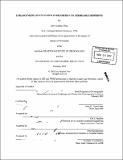| dc.contributor.advisor | John H. Trowbridge. | en_US |
| dc.contributor.author | Fries, Jerry Stephen, 1972- | en_US |
| dc.contributor.other | Woods Hole Oceanographic Institution. | en_US |
| dc.date.accessioned | 2005-09-27T20:19:47Z | |
| dc.date.available | 2005-09-27T20:19:47Z | |
| dc.date.copyright | 2002 | en_US |
| dc.date.issued | 2002 | en_US |
| dc.identifier.uri | http://hdl.handle.net/1721.1/29054 | |
| dc.description | Thesis (Ph. D.)--Joint Program in Oceanography (Massachusetts Institute of Technology, Dept. of Civil and Environmental Engineering, and the Woods Hole Oceanographic Institution), 2002. | en_US |
| dc.description | Includes bibliographical references (leaves 137-143). | en_US |
| dc.description.abstract | Predictions of deposition rate are integral to the transport of many constituents including contaminants, organic matter, and larvae. Review of the literature demonstrates a general appreciation for the potential control of deposition by bed roughness, but no direct tests involving flat sediment beds. Understanding the mechanisms at work for flat sediment beds would provide the basis for exploring more complicated bed conditions and the incorporation of other transport processes, such as bioturbation and bedload transport. Generally, fine particle deposition rates are assumed to be equivalent to the suspension settling velocity, therefore, deposition rates in excess of settling are considered enhanced. Flume observations of deposition were made using treatments that covered a wide range of flow, particle, and bed conditions. Specific treatments demonstrated large enhancements (up to eight times settling). Delivery of particles to the interface is important, but models based on delivery alone failed to predict the observed enhancement. This necessitated the development of a new model based on a balance between delivery and filtration in the bed. Interfacial diffusion was chosen as a model for particle delivery. Filtration of particles by the bed is a useful framework for retention, but the shear in the interstitial flow may introduce additional factors not included in traditional filtration experiments. | en_US |
| dc.description.abstract | (cont.) The model performed well in prediction of flow conditions, but there remained a discrepancy between predictions and observed deposition rate, especially for treatments with significant enhancement. Fluid flow predictions by the model, such as slip at the sediment water interface and fluid penetration into the sediment, appeared to be supported by flume experiments. Therefore, failure to predict the magnitude of enhancement was attributed to far greater filtration efficiencies for the sediment water interface than those measured in sediment columns. Emerging techniques to directly measure fluid and particle motion at the interface could reveal these mechanisms. The observation of enhanced deposition to flat sediment beds reinforces the importance of permeable sediments to the mediation of transport from the water column to the sediment bed. | en_US |
| dc.description.statementofresponsibility | by Jerry Stephen Fries. | en_US |
| dc.format.extent | 156 leaves | en_US |
| dc.format.extent | 8364799 bytes | |
| dc.format.extent | 8364557 bytes | |
| dc.format.mimetype | application/pdf | |
| dc.format.mimetype | application/pdf | |
| dc.language.iso | eng | en_US |
| dc.publisher | Massachusetts Institute of Technology | en_US |
| dc.rights | M.I.T. theses are protected by copyright. They may be viewed from this source for any purpose, but reproduction or distribution in any format is prohibited without written permission. See provided URL for inquiries about permission. | en_US |
| dc.rights.uri | http://dspace.mit.edu/handle/1721.1/7582 | |
| dc.subject | Joint Program in Oceanography. | en_US |
| dc.subject | Civil and Environmental Engineering. | en_US |
| dc.subject | Woods Hole Oceanographic Institution. | en_US |
| dc.title | Enhancement of fine particle deposition to permeable sediments | en_US |
| dc.type | Thesis | en_US |
| dc.description.degree | Ph.D. | en_US |
| dc.contributor.department | Joint Program in Oceanography | en_US |
| dc.contributor.department | Woods Hole Oceanographic Institution | en_US |
| dc.contributor.department | Massachusetts Institute of Technology. Department of Civil and Environmental Engineering | |
| dc.contributor.department | Massachusetts Institute of Technology. Department of Ocean Engineering | |
| dc.identifier.oclc | 50438163 | en_US |
